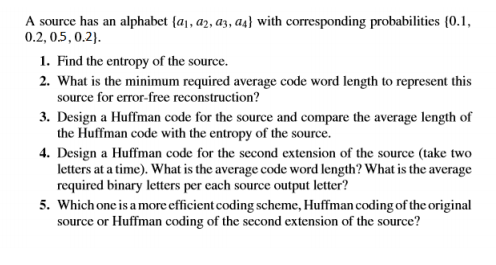A source has an alphabet {aj, a2, az, as} with corresponding probabilities (0.1, 0.2, 0,5, 0.2). 1. Find the entropy of the source. 2. What is the minimum required average code word length to represent this source for error-free reconstruction? 3. Design a Huffman code for the source and compare the average length of the Huffman code with the entropy of the source. 4. Design a Huffman code for the second extension of the source (take two letters at a time). What is the average code word length? What is the average required binary letters per each source output letter? 5. Which one is a more efficient coding scheme, Huffman coding of the original source or Huffman coding of the second extension of the source?
A source has an alphabet {aj, a2, az, as} with corresponding probabilities (0.1, 0.2, 0,5, 0.2). 1. Find the entropy of the source. 2. What is the minimum required average code word length to represent this source for error-free reconstruction? 3. Design a Huffman code for the source and compare the average length of the Huffman code with the entropy of the source. 4. Design a Huffman code for the second extension of the source (take two letters at a time). What is the average code word length? What is the average required binary letters per each source output letter? 5. Which one is a more efficient coding scheme, Huffman coding of the original source or Huffman coding of the second extension of the source?
Computer Networking: A Top-Down Approach (7th Edition)
7th Edition
ISBN:9780133594140
Author:James Kurose, Keith Ross
Publisher:James Kurose, Keith Ross
Chapter1: Computer Networks And The Internet
Section: Chapter Questions
Problem R1RQ: What is the difference between a host and an end system? List several different types of end...
Related questions
Question
4 and 5. parts

Transcribed Image Text:A source has an alphabet {a, a2, az, as} with corresponding probabilities {0.1,
0.2, 0.5, 0.2).
1. Find the entropy of the source.
2. What is the minimum required average code word length to represent this
source for error-free reconstruction?
3. Design a Huffman code for the source and compare the average length of
the Huffman code with the entropy of the source.
4. Design a Huffman code for the second extension of the source (take two
letters at a time). What is the average code word length? What is the average
required binary letters per each source output letter?
5. Which one is a more efficient coding scheme, Huffman coding of the original
source or Huffman coding of the second extension of the source?
Expert Solution
This question has been solved!
Explore an expertly crafted, step-by-step solution for a thorough understanding of key concepts.
Step by step
Solved in 2 steps

Recommended textbooks for you

Computer Networking: A Top-Down Approach (7th Edi…
Computer Engineering
ISBN:
9780133594140
Author:
James Kurose, Keith Ross
Publisher:
PEARSON

Computer Organization and Design MIPS Edition, Fi…
Computer Engineering
ISBN:
9780124077263
Author:
David A. Patterson, John L. Hennessy
Publisher:
Elsevier Science

Network+ Guide to Networks (MindTap Course List)
Computer Engineering
ISBN:
9781337569330
Author:
Jill West, Tamara Dean, Jean Andrews
Publisher:
Cengage Learning

Computer Networking: A Top-Down Approach (7th Edi…
Computer Engineering
ISBN:
9780133594140
Author:
James Kurose, Keith Ross
Publisher:
PEARSON

Computer Organization and Design MIPS Edition, Fi…
Computer Engineering
ISBN:
9780124077263
Author:
David A. Patterson, John L. Hennessy
Publisher:
Elsevier Science

Network+ Guide to Networks (MindTap Course List)
Computer Engineering
ISBN:
9781337569330
Author:
Jill West, Tamara Dean, Jean Andrews
Publisher:
Cengage Learning

Concepts of Database Management
Computer Engineering
ISBN:
9781337093422
Author:
Joy L. Starks, Philip J. Pratt, Mary Z. Last
Publisher:
Cengage Learning

Prelude to Programming
Computer Engineering
ISBN:
9780133750423
Author:
VENIT, Stewart
Publisher:
Pearson Education

Sc Business Data Communications and Networking, T…
Computer Engineering
ISBN:
9781119368830
Author:
FITZGERALD
Publisher:
WILEY